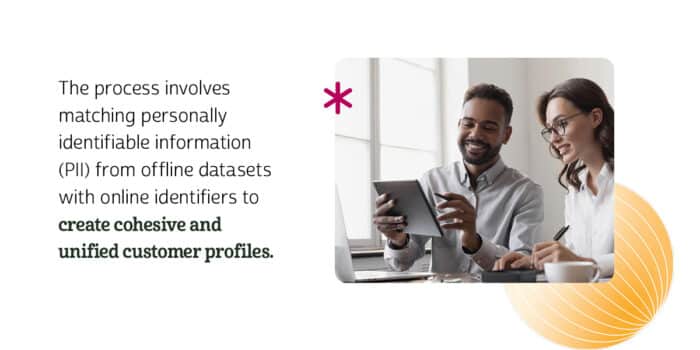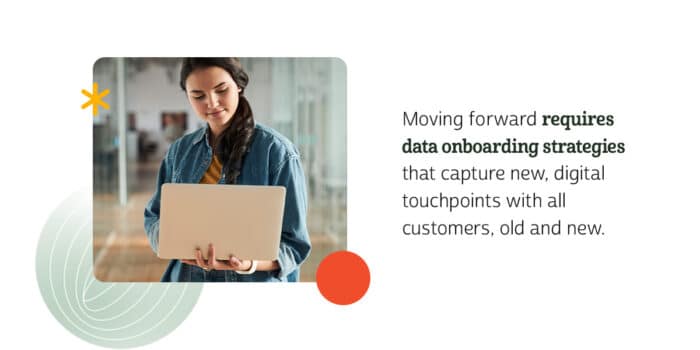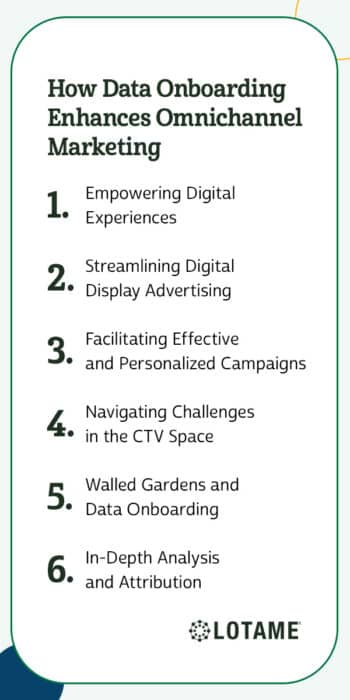
- What Is Offline Data?
- What Is Online Data?
- What Is Data Onboarding?
- How Does Data Onboarding Work?
- Challenges of Onboarding Data
- Benefits of Data Onboarding
- How Data Onboarding Enhances Omnichannel Marketing
- Introducing Lotame Data Onboarding
- Navigating Complexity: The Ever-Evolving Landscape of Data Onboarding
The buzz surrounding the importance of utilizing offline data for online marketing campaigns has been hitting the AdTech space hard, and everyone is trying to jump on this bandwagon. But what exactly is offline data, and how do you onboard it into an online space, especially when data privacy restrictions are only getting tighter? Reaching the right person, whether offline or on, at the right time is critical for the success of any campaign.
This article will tackle everything you need to know about offline and online data, how companies can match them, and how data onboarding can help you bolster your digital marketing strategies.
What Is Offline Data?
While 31% of American adults are almost constantly online, how they spend that time offers only a tiny view of who each user is and how likely they are to be a good fit for your product or brand. Offline data fills in the missing pieces from online transactions, making it an invaluable resource when looking to create a successful people-based data marketing strategy.
Offline data originates from offline sources such as:
- In-store purchases
- Loyalty card data
- Survey responses
- Demographic data
- Contact information
You can usually pull this data from customer relationship management (CRM) data files or purchase it from offline data vendors.
As powerful as offline data is, it does indeed sit offline, and for the longest time, marketers have had tremendous difficulty effectively connecting it to online users without sacrificing consumer privacy.
What Is Online Data?
Online data captures the behaviors, interests, and interactions of consumers that are exhibited across the internet, as gathered by cookies. By capturing the ways in which consumers are interacting across these different digital touchpoints, marketers can build a detailed picture of them, answering questions like:
- What content are they consuming?
- What device do they use most often?
- What specific actions do they take online?
Combining these data points provides rich customer insights you can use for content development, ad targeting, and creative messaging.
What Is Data Onboarding?

Data onboarding is the process of transferring offline data to an online environment for marketing needs.
The process involves matching personally identifiable information (PII) from offline datasets — often from your CRM platform — with online identifiers to create cohesive and unified customer profiles.
Some examples of PII you might onboard include:
- Name
- Street address
- Email address
- Telephone number
- Date of birth
- Social Security number
The online identifiers you might use can span from IP addresses and first-party cookies to mobile ad IDs (MAIDs) and universal IDs.
Once the profiles are complete, you can find the same customers online for more effective marketing and advertising campaigns.
How Does Data Onboarding Work?
In the offline advertising world, unique identifiers can include anything from email addresses to physical addresses to names. However, bringing that data online requires you to make a “match” between the offline profile (those unique identifiers) and the online profile (brought to you by cookies).
Combining these data points and signals unlocks a holistic view of customer journeys and behaviors across your various offline and online channels — which is critical as more consumers discover the convenience of seamlessly switching between devices, experiences, and platforms.
Probabilistic vs. Deterministic Matching
Data matching, a fundamental aspect of onboarding, can be achieved through two primary approaches: probabilistic or deterministic matching. The choice between these methods depends on several factors:
- Quality and quantity of available data
- Sites or devices you are linking
- Overarching objective of the data onboarding process
Probabilistic matching involves leveraging AI and machine learning algorithmic models to assess the likelihood that offline consumer data corresponds to its online counterpart. On the other hand, deterministic matching aims to identify an exact one-to-one match between offline and online profiles. Marketers often use a combination of both approaches, as many CRM datasets may not be large enough for deterministic matching at scale.
Challenges of Onboarding Data

In an era of short attention spans, digital distractions, and cross-device advertising, keeping pace with consumers’ digital footprints is exhausting. Effective data onboarding is often a top marketing hurdle due to the massive quantities of data companies need to collect and manage.
For brands with years of historical records, these pitfalls hit hard. Moving forward requires data onboarding strategies that capture new, digital touchpoints with all customers, old and new. After all, a brand can’t implement a successful onboarding strategy without quality customer data.
But for some brands, getting that data can be challenging. Flawed data collection and targeting methods often limit match rates and impact consumer trust. However, marketers can offer incentives so individuals voluntarily share personal details through channels such as:
- Account sign-ups
- Loyalty programs
- Subscriptions
Brands must carefully assess the value and actionability of this data to ensure it aligns with their target customers before taking any decisive action.
Even when brands possess customer data, though, activation can be challenging due to its dispersion across various departments, including:
- Customer services
- E-commerce
- Marketing
- Media buying
Breaking down these data silos and transitioning to a unified Data Collaboration Platform (DCP) is crucial for ensuring data accessibility throughout the organization. Although implementing a DCP introduces its own set of challenges, recent advancements in machine learning have made the process a little smoother by simplifying tasks such as data transformation and duplication filtering.
Benefits of Data Onboarding
Onboarding your offline data and mapping it to customers’ online profiles creates a holistic cross-platform view of your customers and prospects. By combining all that data in one central platform, such as a data collaboration platform, or DCP, you can:
- Identify your most important audiences
- Learn more about each individual consumer
- Maximize ROI generation from your marketing efforts
- Perform better market segmentation
- Generate better insights into customer behavior and preferences
- Deliver more personalized advertising
Where you may once have been limited to sending ads offline to a specific targeted customer, data onboarding allows you to target the same customer’s profile online. With that, your campaign gains a consistent and relevant tone and message across all your owned media platforms.
Here’s an example. Let’s say a shoe store has a ton of loyalty card customer data sitting offline that they would like to bring online as a way to retarget customers who purchased a specific brand of flip-flops. The store’s CRM platform captured the customer purchase data when they swiped their loyalty card in-store, logging exactly what style they bought and when.
A data onboarder will onboard the data and match each point to specific online profiles via cookies, which allows you to send targeted ads reminding these customers of the flip-flops they showed interest in offline. Because the offline data and online profiles match, the shoe store has an even higher chance of converting those customers online.
How Data Onboarding Enhances Omnichannel Marketing
Successful data onboarding provides brands and their agencies with significant advantages across a spectrum of channels.
1. Empowering Digital Experiences
Personalized online experiences are essential for driving conversions in an era where everyone expects customization options. Customer data onboarding facilitates real-time delivery of highly tailored and engaging digital experiences on a brand’s owned properties and channels.
For example, utilizing onboarded data in personalization platforms allows brands to adapt website content, offers, and messaging according to the customer and the instance. Monitoring the effects on customer relationships, engagement, and conversion rates becomes a data-driven endeavor.
2. Streamlining Digital Display Advertising
Data onboarding streamlines the transmission of data from marketers to their demand-side platforms. Simplifying this process enables precise targeting of specific audience segments, ensuring that the right ads are delivered to the right consumers at the right time.
3. Facilitating Effective and Personalized Campaigns
Data-driven strategies such as suppression, retargeting, and lookalike modeling enable brands and agencies to create more effective and personalized campaigns.
Device graphs associating device IDs with customer data enable a consistent experience across devices, minimizing overexposure through frequency capping.
4. Navigating Challenges in the CTV Space
While the Connected TV (CTV) space is still evolving, platforms are developing capabilities for marketers to onboard their data directly, similar to a private exchange. Integrating data from various sources allows marketers to deliver more relevant and personalized ads to specific households.
5. Walled Gardens and Data Onboarding
Walled gardens, such as social platforms, Google’s advertising suite, and retail media networks, allow marketers to directly utilize data onboarding to reach consumers within their closed digital ecosystems.
Additionally, match rates and accuracy within these ecosystems tend to skew higher than the general digital environment since most users sign up via their primary email. It’s a win-win — you get the data you need, and users get the marketing messages they want.
6. In-Depth Analysis and Attribution
Strong data analytics capabilities enable you to generate the valuable insights you need to drive real results. Anonymized data passed back to brands and agencies that onboard their data allows for in-depth analysis of cross-channel measurement and attribution.
Plus, collaboration with attribution partners provides a holistic view of the customer journey, enabling informed decisions for future campaigns.
Introducing Lotame Data Onboarding
Your first-party data is now more actionable and valuable than ever with Lotame Onboarding. Our onboarding solution accelerates the use of first-party data activation by allowing digital marketers to bring their collected identifiers, such as email addresses, into its platform. From here, digital marketers can perform a variety of tasks such as enriching that data for precise audience targeting, generating lookalike models for increased scale, permissioning data to partners for data collaboration, and performing deep dive analyses into consumer preferences.
Lotame is proud to offer an onboarding solution (currently available in the U.S. only) as part of our Spherical data collaboration platform that truly allows digital marketers to thrive in an increasingly cookieless world.
Navigating Complexity: The Ever-Evolving Landscape of Data Onboarding
Customer data onboarding is complicated as it is, and it becomes more complex with each media channel you add — but it’s a critical component in today’s omnichannel world. Whether you manage your data internally or externally, your organization can no longer afford to ignore the significance of data onboarding in an increasingly dynamic and omnichannel-driven marketing landscape.
Fortunately, today’s brands have access to specialized data onboarding companies and a growing number of data-savvy agencies that can assist with the heavy lifting. That’s where Lotame’s end-to-end data collaboration platform, Spherical comes in.
Get started today by requesting a free demo. We’ll show you how our secure solution can help you make smarter, faster, and easier decisions with your data.